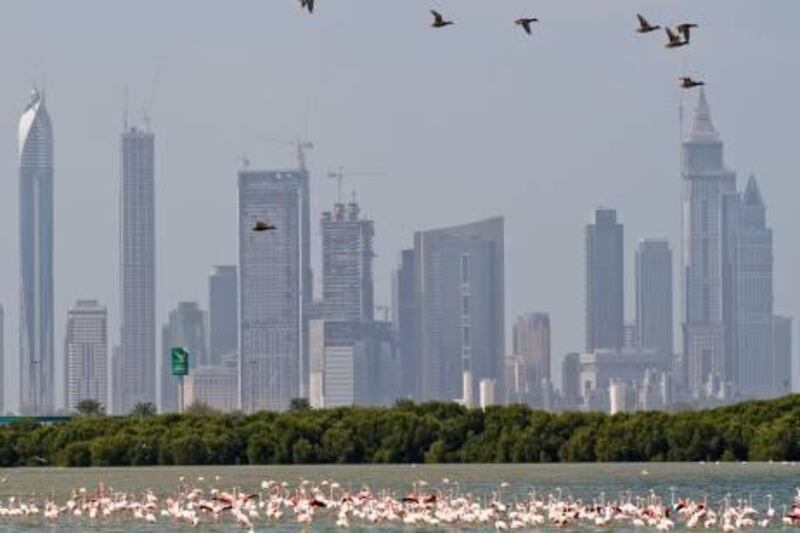DUBAI // Ten per cent of the total land area of Dubai, about 411 square kilometres, will be dedicated to nature conservation by 2014.
The total protected area currently accounts for approximately 7.3 per cent of Dubai's 4114 square kilometres, according to Mohammed Abdul Rahman Hassan, head of the Marine Environment and Wildlife Section at Dubai Municipality.
After his speech at the United Nations-backed World Migratory Birds Day yesterday, Mr Hassan said the 10 per cent target had been set by the Convention on Biological Diversity, an international treaty signed by 192 member states.
"Each location has to satisfy a certain criteria based on international standards, with aspects such as flora and fauna being considered according to best practices," said Mr Hassan. The issue is of global concern, he said.
There are two main areas officially described as protected zones: one is Ras Al Khor Wildlife Sanctuary, which is the site at which the UAE signed the Ramsar Treaty - an intergovernmental commitment to maintain sustainable use of wetlands.
Last January the municipality recorded about 25,000 migratory birds at Ras Al Khor - an area of only 13 square kilometres - from approximately 88 species.
The second is Al Wathba Wetland Reserve in Abu Dhabi, which incorporates man-made and natural water areas. The reserve is home to almost 232 species of birds, as well as reptiles, small mammals and insects.
"Although human survival depends on some transformation of natural areas, sustainable use of land is vital to reduce the impact on natural resources and to protect animals such as birds," said Mr Hassan.
Salim Javed, the manager of Biodiversity Assessment and Monitoring at Environment Agency Abu Dhabi, said it was important to safeguard additional sites that have yet to be classified as protected. These include Khor Zowra, Ajman, Khor Al Bida, Umm al Qaiwain and Khor Jazira in Ras al Khaimah.
To do this, inter-emirate co-operation is needed.
"We have international and inter-GCC dialogue, so we need to focus on a local framework to increase the protected areas," said Mr Javed.
This year's theme for World Migratory Birds Day (WMDB) was "Land use changes from a bird's-eye view", and a lecture series hosted by Dubai Municipality focused on how human changes - such as intensive agriculture, urbanisation and deforestation - have a negative impact on migratory birds.
At least 50 billion birds migrate every year across eight recognised paths worldwide, according to Mr Javed.
"Changes in the sea, island habitat and land in Dubai and Abu Dhabi are dramatic," said Mr Javed. "There are about 441 bird species in the UAE and most are migratory. A few million others depend on our shores."
About 11 per cent of migratory bird species are threatened, he said.
"Humans have increased the species extinction rate up to 1,000 times, and 60 per cent of the earth's ecosystems have been transformed over the last 300 years. We are taking away natural habitats," added Mr Javed.
With advanced technology, the Environment Agency-Abu Dhabi has been tracking paths of migratory birds such as Osprey, Sooty Falcon and Steppe Eagle.
"We have satellite bands that can track the birds in real time," said Mr Javed. "They face perilous journeys, extreme weather, food shortage and potential predators."
Information obtained, he said, is key to understanding routes, stopovers and also allows for discovery of new areas of conservation that can help in future town planning.
"We have also been tracking Greater Flamingos since 2005 and have proposed a new flamingo and waterbirds sanctuary which is awaiting official approval," he said.
A flamingo breeding programme at Dubai Zoo has also been successful, according to Dr Reza Khan, a specialist in wildlife and zoo management at the municipality. "The fact that they bred at all was a miracle, since this species is very particular about the food they eat and their surroundings," said Mr Khan. "We are waiting for the right opportunity to release them."
A plan to take a group of flamingos from the zoo to Ras Al Khor Wildlife Sanctuary to see if they will breed there too, is also being considered.
[ melshoush@thenational.ae ]






